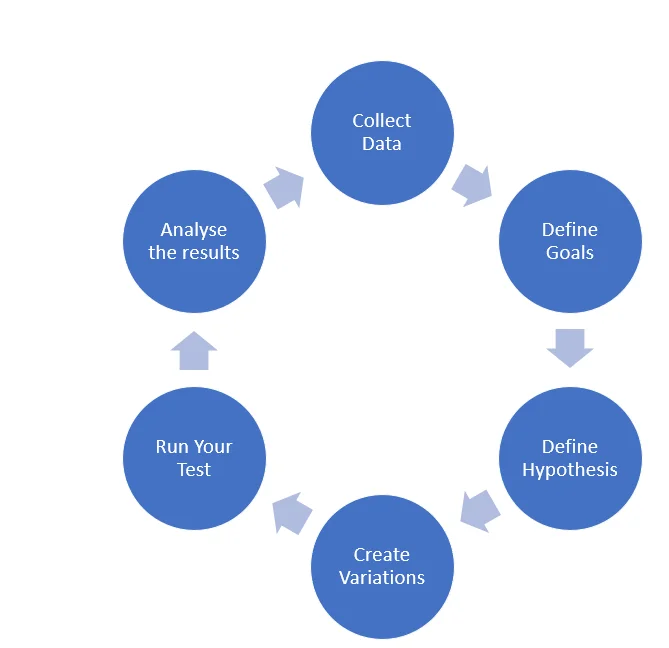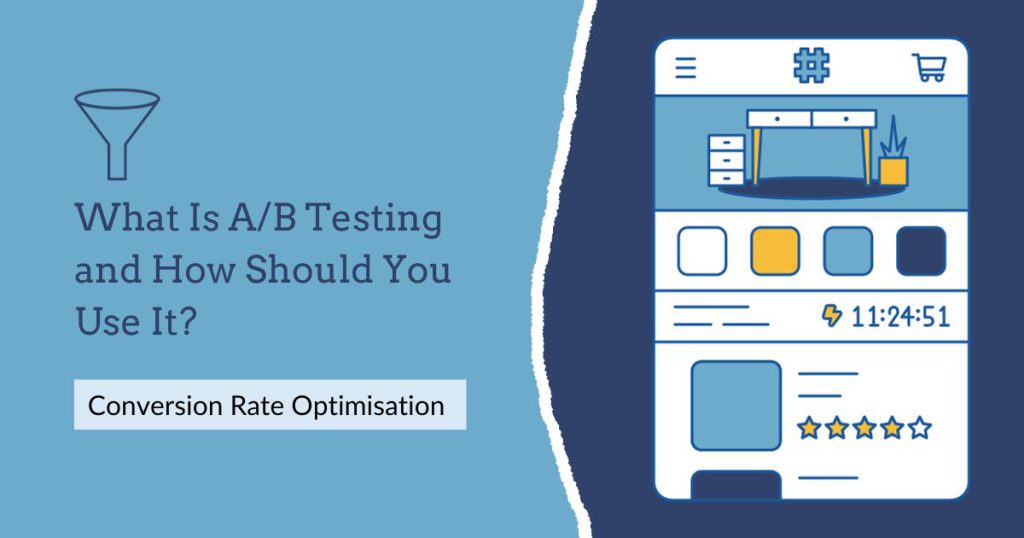Did you know you can increase sales without increasing traffic?
Now, I know that you’re thinking. It seems a little dubious.
But it’s true.
A/B testing is a fantastic way of improving your website’s conversion rate with a strategy based on facts and data.
In its simplest form, an A/B test runs two versions of the same page to a random audience selection.
The aim of this is to find out how an audience reacts to these new changes and if it helps you reach your business goals.
You can use A/B testing on everything, from websites to landing pages, advertising to social media messages. It’s an important marketing tool which helps you gain the best bang for your buck.
Let’s explore what A/B testing is and how it can improve your conversion rate.
Table Of Contents
- What is Conversion Rate?
- What is A/B Testing?
- The A/B Testing Process
- 1. Collect Data
- 2. Defining your goals
- 3. Define Hypothesis
- 4. Create Variations
- 5. Run Your Test
- 6. Analyse the results
- What Is A/B testing in Digital Marketing?
- Does A/B testing damage SEO?
- Where can A/B testing be used?
- What is A/B Testing for Landing Pages?
- Where should you start with A/B Testing?
What is Conversion Rate?
A/B testing usually revolves around conversion rate.
A conversion rate is a percentage of people who land on a page and complete a goal.
So, for example, a e-commerce store gets 100,000 visitors every month. The website’s goal is to sell products. Of those 100,000 people who land on the website, 4,000 people buy something.
So the conversion rate equation would look like this:
4,000/100,000*100= 4%
Conversion rate isn’t just about sales. A conversion rate could look at:
- How many leads filled out a lead capture form
- Email open rates or click-through rates
- PPC click through
- Social media impressions or engagements
- Click-to-call buttons
- Appointment bookings
Your conversion goals can be anything you need to hit your business goals.
What is A/B Testing?
A/B testing looks into how to improve the conversion rate of a specific goal based on improving your marketing material.
So how do you do that?
A/B testing runs two different versions of a piece of marketing collateral to audiences. This could include a webpage, an email, an ad or more.
These tests usually include the original (control) and one changed version (variation). These are then shown to your audience without them knowing it’s a test. Traffic to these variations is divided between a predetermined audience split, such as 50/50, 75/25, etc.
A/B testing software will then track the conversion rates of these pages. Whichever page gains the highest conversion rates or biggest sales will be crowned champion. You can then decide to implement those changes permanently or try further tests.
It’s important that you only run one test at a time, especially if you are just starting out. Running multiple tests can muddy results, and if you are new to A/B testing, it can be very difficult to see the overall effect of each changed element. Stick to just one test at a time for the best results.
The A/B Testing Process
There is a method to A/B Testing that you should follow for every cycle of testing you do.

1. Collect Data
You need to collect data on your current audience before you do anything. You’ll want to start with a customer persona. Look at how they interact with your brand online:
- Are they mobile or desktop shoppers?
- Do they respond to certain words or phrases? E.g Dabbing and flossing mean different thing to different generations.
- What other brands and celebrities influence your audiences?
- How long is the buyer’s journey?
You may need to run surveys, polls and customer research to find out more about your audience. However, most questions can be answered by playing with your Google Analytics accounts.
Once you have an idea of where your audience currently is, you can work out how to improve.
Examples:
- If your shoppers are 90% mobile, then you may want to focus on your mobile site.
- If your audience religiously shop on female fashion sites, then you may want to emulate the layout and wording, even if you sell furniture or food.
- If your audience are 65+ and wear reading glasses, then you may want to use clearer layouts and larger fonts.
Now have a look at your pages in your analytics software around these assumptions:
- Look for pages with high bounce rates.
- Look at your conversion funnels. Are they any obvious leaks?
- Check your exit pages. Are there any pages that send alarm bells?
2. Defining your goals
Your second step is to define your goals. More importantly, “What does success mean to you”.
Most businesses will have predefined business goals, but how do these tie in to your A/B testing?
Your goals need to be SMART goals:
- Specific
- Measurable
- Achievable
- Relevant
- Timely
A goal of “make more money” isn’t a good goal. It doesn’t explain how much is more. It doesn’t have any end date. Goals that are too vague are less likely to be achieved. This would be a better goal:
“Increase annual turnover by 15% by December 2020.”
Write down one, two or three goals that you want to achieve with your split testing. Ome example goals are:
- Raise average order value from £20 to £30 by December 2020
- Increase conversion rate across whole website from 1.5% to 3.5% by December 2020
- Increase email signups from 1000 monthly subscribers to 2000 monthly subscribers by December 2020.
3. Define Hypothesis
Now you have your audience and your goals, it’s time to work out your hypothesis.
Your hypothesis is made up of two things:
- What you think the problem is
- How you think it can be solved
Let’s say you have spotted a mass exodus on all category pages, but your product pages are converting well. Your category pages might not be clear for customers and that is affecting those customers from clicking through to the products they need.
You should run a user research to try to determine why someone wouldn’t click through to the product. If that isn’t an option, brainstorm ideas with your team, family, friends, and others to gather a list of ideas of how to improve.
You work out from this data what steps you can take.
In this example, tests proved that the products needed to look more clickable. So, the marketing team might want to set up your split test with a CTA button.
4. Create Variations
You will need to grab some A/B testing software unless you have a super-duper developer who can create the system themselves. Software varies from free to very expensive, but the more you spend, the more options or support you get. It’s best to have a look around to see your options.
You could run three pages for your button test:
- Control: Your original page
- Variation one: A button which reads “buy now”
- Variation two: A button which read “find out more”
Your metric for success is:
- Increased conversion rate based on total website users vs purchases
- Steady or improved conversion rate from product traffic vs purchases
Once you have all these up and running, it’s time to get going.
5. Run Your Test
Once you are ready to, you can start running your tests.
Your variation will be sent to random users, and the software will start to collect data.
You will need to run your test for a long enough time that you get enough data to make a decision. Ideally, you should have at least 1000 people go through your test.
6. Analyse the results
Gather all the results from your tests. More expensive software will help you determine the winner. You’ll need to check the statistical significance of the results.
For example, let’s say we got the following results
- Traffic: 1000 users
- Control: 2.4%
- Variation 1: 2.5%
- Variation 2: 3%
Although Variation 2 showed definite increase in conversion, in reality, that’s only an increase of 6 people. This could just be an anomaly, those 6 people may have had the intention to buy then and there regardless of which test they saw. However, let’s say we had 100,000 people going through that test, you now have a difference of 600 people, which is much less of a coincidence.
If we had these results instead:
- Traffic: 1000 users
- Control: 2.4%
- Variation 1: 2.5%
- Variation 2: 12%
The difference between the control and variation 2 is a far more significant jump, in both percentage and the number of people converting.
What Is A/B testing in Digital Marketing?
Digital Marketing is all about results.
Your boss wants to see an improvement in campaign results year on year. This could mean more sales, more followers on social media or more visitors to a website.
With A/B Testing you can run variations of different social media statuses, email subject lines or landing pages in order to see which ones perform the best.
A/B testing helps you make informed decisions for your marketing campaigns. Testing can help users understand how to use your website, help improve click throughs on emails or improve ROI on advertising.
A/B testing can also help you get into the mind of your audience. You can test how your unique audience reacts to different call to actions, slogans and more. You can use this information across your entire campaign, including print adverts.
Without A/B testing, the changes you make could be damaging to your brand. It may confuse audiences who do not follow the same thought process as you. Afterall, you are not your target audience. You are too close to your project and your industry.
A/B testing is also a great way to do a soft launch of new website. You can test individual elements and prepare your audience for bigger changes. This way, you won’t scare away your usual customers.
There are a huge amount of things to look at when Ab testing for digital marketing, but we recommend starting with wording or pictures. Finding out which words or pictures capture the heart of your audience can have far reaching effects across all of your channels.
Does A/B testing damage SEO?
When done properly, A/B testing will not hurt your SEO. Google approves of A/B testing so much that it has released it’s own A/B testing tool.
As long as you do not cloak content, and use “rel=canonical” tags, your tests won’t negatively affect your rankings.If you aren’t sure, double check with an SEO expert that your tests have been properly set up.
In fact, A/B testing can help your SEO. You can use A/B testing to test different variations of pages which aim to boost certain ranking factors.
For example, social shares are a ranking factor, so you could A/B test the placement of social share buttons on your blog to try to increase shares.
Or, you could A/B test emails which ask for reviews on Google. You could test various subject lines and email content to gain the most reviews.
You could also use your A/B testing results for CTAs on your meta-titles and descriptions to increase your click-through rate.
Additionally, improving the customer journey, solving website problems and increasing customer satisfaction are all factors that affect in SEO.
Where can A/B testing be used?
A/B testing isn’t just limited to websites. There are loads of places where A/B testing can be used to increase performance.
A/B tests can be run on:
- Email subject lines
- Email content
- Facebook Adverts
- Google PPC and Display Ads
- Facebook statuses
- Landing Page Software
- Pop-ups and widgets
- Apps
And this is just a few places. You can also run A/B tests in real life, but it is a little trickier.
What is A/B Testing for Landing Pages?
The most common use of A/B testing is for landing pages. Landing pages are webpages which usually contain a data capture form. Paid advertising usually drives traffic to these pages, which then convert to leads.
As the main purpose of these pages are to convert as many leads as possible, they are perfect for A/B testing.
Most landing page builders, such as Clickfunnels or Lead Pages, will have built-in A/B test functionality.
A few tests to try would be:
- Having the form on the left, the right or the middle
- Trying different CTAs on the submit button
- Testing button animations (e.g. a wiggling button over a glowing button)
- Short landing pages versus long ones
Where should you start with A/B Testing?
Pretty much everything can and should be A/B tested. If you are just starting out on the A/B testing journey, you should start with easy changes first. Start with single pages, such as your homepage, then move up to more complicated changes, such as product pages.
Start with your CTAs. Make sure your banners and other home page factors have the wording that moves your audience to action.
You should also test:
- Headlines – Which wording is more persuasive?
- Colours – Which colours work best? Does a stronger colour capture attention? Do pastels help drive the eye to important messages in bold colours?
- Images – Female vs male, smiling vs sad, People vs landscapes. Which captures the audience’s attention?
- Form length – does a longer form make more of an impact
- Email signup placements – does the placement of your email list capture more data?
Without A/B testing, you don’t know if your campaign is performing to its best potential. A/B testing is a fantastic way to grow your business. You can increase your goals with confidence that you are going in the right direction.
Small tweaks to your business can be an easy way to hit goals – you could increase your profits without needing to raise your traffic.
If you are heading out on your own with A/B testing, you are not alone. There is a whole bunch of information on A/B testing just waiting to be discovered. But, if you are worried about adding more work to your day then consulting an agency about your A/B testing goal might be your next step. They can help get you on your way to website success.
Either way, you know your marketing is going to be data-driven and on it’s way to success.

